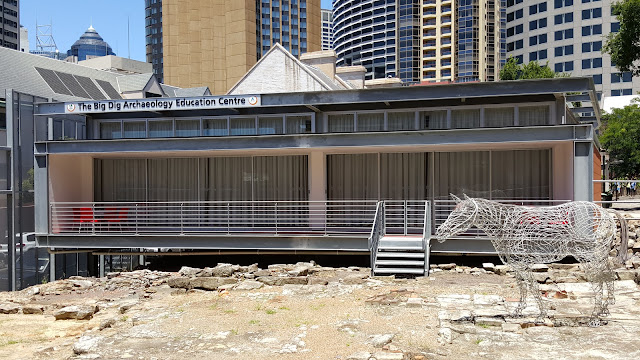For my major research project, I have researched and written a brief history of The Rocks in Sydney, and specifically the site of The Big Dig and Sydney Harbour YHA, who are the organisation that I have been working with. My research has briefly canvassed the pre-colonial history of the area, as well as the history from colonial times until the period immediately following WW1. I found this continuity and background to be important for the understanding of my research, especially considering that the intended audience for this piece is both international travellers, and school students.
My research was focussed on the industrial era of The Rocks, whereby the turn-of-the-century, working class neighbourhood was transformed into an area of industry. In this research I explore the impact of the demolition of many dwellings in the area, the Norton Griffiths Machinery and Joinery Works, the City Railway Workshop, as well as the clearing in preparation for the Sydney Harbour Bridge approach. This area of focus was selected because it was of the greatest aid to my organisation. This time period was the one with the least information available, and that my organisation would most like from me, to be able to share with their visitors, both from overseas, and from students on excursions. Crucially, this research aligns with the school student program they run, entitled Shopfront to Western Front.
Author: Caitlin Preston
An Archaeological Site Right in Sydney’s The Rocks

The organisation that I am working with for my major project as a part of History Beyond the Classroom is Sydney Harbour YHA & The Big Dig Archaeology Centre. This organisation centres around the archaeological site, The Big Dig. The Big Dig, spanning two half-city blocks, is a large archaeological site in The Rocks of Sydney. The artefacts discovered at the site have ranged in date from the 1790s to the 1930s, and it has been suggested that if further excavation was to be undertaken, even older artefacts would be found. The site underwent excavations in 1994, and was then partially left in situ and used as a display feature of Australian history and archaeology. This site has the unique opportunity of bringing together such a valuable piece of history with Australia’s tourism industry, and with many school-aged children, eager to learn more about Sydney’s past.
Sydney Harbour YHA has been built with the unique opportunities of this site in mind. The hostel, which provides accommodation to people travelling, has been built around the site, creating opportunities for visitors to interact with the site. Visitors are able to view the dig site from a series of constructed walkways and glass panels, as well as through the artefacts and explanatory signs that are also on display at The Rocks Discovery Museum. The purpose-built site has been internationally recognised with a UNESCO Asia Pacific Award for Heritage Conservation. The nature of the YHA is that international guests are frequent visitors, and so this combination of tourist accommodation and Australian history is able to be well combined. Visitors both from overseas and the local area are able to view and enjoy the site and its history.
In addition to this, The Big Dig is also heavily involved in educational outreach, providing many school-aged children with the opportunity to visit the site, and engage with archaeology in a hands-on way. The organisation runs a number of in-depth, experiential and curriculum linked programs, aimed at really connecting the students to the material. There are several different programs, delivered through Sydney Learning Adventures, each of which focuses on a particular aspect that the site has to offer, ranging from an exploration of Sydney’s early colonial and convict history to the history of Chinese immigration.
Personally, I find the work that this organisation does to be very interesting, and very valuable to our understanding of Australia’s history, and the place that archaeology holds within in. The Sydney Harbour YHA is an interesting building, which has very cleverly made the archaeological site a feature and attraction, while simultaneously protecting and preserving it. In doing so, the value of the site is able to be articulated to an international audience. As well, I feel that using the site to facilitate the learning of students is very important. Especially for younger students, leaning through engaging and hands-on experiences can be really valuable, and can leave a very lasting impression. I am looking forward to contributing in a small way to this work, and to the preservation and sharing of the history of The Rocks.
